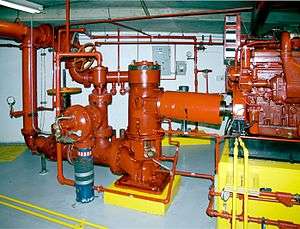Fire pump

A fire pump is a part of a fire sprinkler system's water supply and powered by electric, diesel or steam. The pump intake is either connected to the public underground water supply piping, or a static water source (e.g., tank, reservoir, lake). The pump provides water flow at a higher pressure to the sprinkler system risers and hose standpipes. A fire pump is tested and listed for its use specifically for fire service by a third-party testing and listing agency, such as UL or FM Global. The main code that governs fire pump installations in North America is the National Fire Protection Association's NFPA 20 Standard for the Installation of Stationary Fire Pumps for Fire Protection.[1]
Fire pumps function either by an electric motor or a diesel engine, or, occasionally a steam turbine. If the local building code requires power independent of the local electric power grid, a pump using an electric motor may utilize, when connected via a listed transfer switch, the installation of an emergency generator.
The fire pump starts when the pressure in the fire sprinkler system drops below a threshold. The sprinkler system pressure drops significantly when one or more fire sprinklers are exposed to heat above their design temperature, and opens, releasing water. Alternately, other fire hoses reels or other firefighting connections are opened, causing a pressure drop in the fire fighting main.
Fire pumps are needed when the local municipal water system cannot provide sufficient pressure to meet the hydraulic design requirements of the fire sprinkler system. This usually occurs if the building is very tall, such as in high-rise buildings, or in systems that require a relatively high terminal pressure at the fire sprinkler in order to provide a large volume of water, such as in storage warehouses. Fire pumps are also needed if fire protection water supply is provided from a ground level water storage tank.
Types of pumps used for fire service include: horizontal split case, vertical split case, vertical inline, vertical turbine, and end suction.
Fire Pumps, Circulation Relief Valve
Each pump shall have a circulation relief valve listed for the fire pump service installed and set below the shutoff pressure at minimum expected suction pressure.
Exception: This rule shall not apply to engine-driven pumps for which engine cooling water is taken from the pump discharge.[2]
Jockey pump
A jockey pump is a pump connected to a fire sprinkler system and is intended to maintain pressure in a fire protection piping system to an artificially high level so that the operation of a single fire sprinkler will cause a pressure drop which will be sensed by the fire pump automatic controller, causing the fire pump to start. The jockey pump is essentially a portion of the fire pump's control system.
A jockey pump is sized for a flow less than the flow to one sprinkler in order to ensure a system pressure drop. Hence a jockey pump is an important part of the fire pumps control system.
Jockey pumps are typically small multistage centrifugal pumps, and do not have to be listed or certified for fire system application. The control equipment for jockey pumps may however carry approvals.
Jockey pumps should be sized for 3% of the flow of the main fire pump and to provide 10psi more pressure than the main fire pump (As per Code IS 15105 : 2002)
In the U.S.
The application of a jockey pump in a fire protection system is provided by NFPA 20. They are inspected per NFPA 25 "Inspection and Testing of Water-Based Fire Protection Systems".
In India
In India, the pump manufacturers generally adhere to the TAC (Tariff Advisory Committee) guidelines, although pump manufacturers may also obtain listings with UL or FM Global.
References
| Wikimedia Commons has media related to Firefighting pumps. |
- ↑ "NFPA 20: Standard for the Installation of Stationary Pumps for Fire Protection". Nfpa.org. Retrieved 2011-12-15.
- ↑ https://www.fmglobal.com/assets/pdf/fmapprovals/1319.pdf FM Global, Standards for Fire Pumps
http://publicecodes.cyberregs.com/icod/ibc/2012/icod_ibc_2012_9_sec013.htm
.jpg)